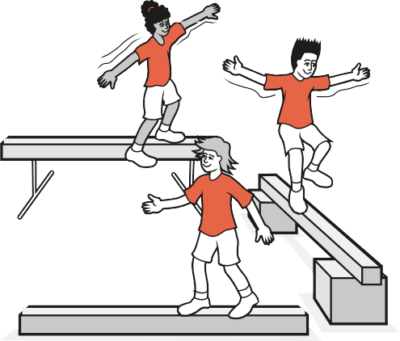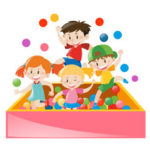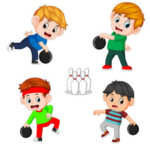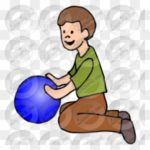
Movement skills/concepts
Dynamic and static balance, space awareness and relationships (with others and equipment).
Set-up
Beams/benches, mats, wobble boards, stilts, Swiss balls, box tops.
Small groups of no more than four, starting at different points of a circuit.
Activity
Children practise the following activities in the circuit.
Beam/bench station: Have three beams/benches at different heights. Children travel along the beam/bench using different locomotor skills (leaps, jumps, walking forwards, backwards, sideways). Then create a sequence (e.g. walk to the end, turn, scale balance, walk to the centre, do a cat leap, walk to the end, do a jump, quarter turn to land).
Balance on less stable objects: Have a wobble board (different heights and bases), stilts and balance (Swiss) ball. Children experiment with different ways of balancing on apparatus, using different body parts (e.g. standing, sitting, kneeling). Can you balance on the apparatus with your eyes closed?
Stationary balances on equipment: Have a selection of box tops. Children create a series of balances, without leaving the surface of the box, transferring from one balance to the next. Then create a sequence of balances on the box that includes: an approach (e.g. run, walk) to the box; a transfer (e.g. jump, step) onto the box; a series of balances on the box; and a dismount (e.g. straddle to land) from the box.
Inverted balances on ground: Try a cartwheel on the ground, on a line (it is like a handstand but sideways). Once their legs are in the air, children bring them together and twist the body so that they land to the left and right – sometimes this is called a round-off. Try a cartwheel with only one hand on the ground.
A floor routine: Have a mat area of approximately 6–10 metres square, space permitting. Children create a sequence that combines stationary balances and travelling movements (e.g. running, galloping, skipping). Include at least three balances, each with a different base of support; a minimum of three travels, with a change in direction and level; and one inverted balance. Have a beginning and an end shape.
Can you see …?
- tight muscles
- wide base of support
- slow control when engaging and disengaging
- arms extended for balance (counterbalance)
You could ask …
How can you safely control engaging and disengaging from a stationary balance?
COOL DOWN/ CLOSURE
Review Skill/Activity, stretching, and questions.







